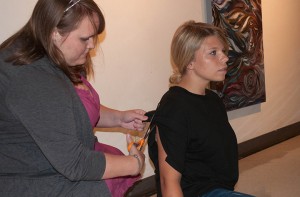By Connor Yearsley
Reporter

Courtesy Photo
Several Baylor students will have their clothes cut off at 7:30 p.m. Thursday.
The event, in Jones Theatre in the Hooper-Schaefer Fine Arts Center, will recreate Yoko Ono’s iconic performance entitled “Cut Piece.” Interviews, audience reactions and a reception will follow.
Ono, famous for her marriage to John Lennon of The Beatles and for her social activism, first performed the piece in Japan in 1964. Ono remained still and silent while audience members, who were hesitant at first, came up and cut increasingly larger pieces of her clothing off.
Some have speculated this was an anti-Vietnam War statement, or a feminist statement, or both. There may have been still other motivations involved.
Ono has been reticent regarding the piece.
“In the 1960s I did it out of anger,” Ono said after a 2003 performance in Paris.
Some people think the piece speaks on despair, helplessness and anger as well as love, tolerance and perseverance. Some think it speaks on the unchanging nature of the inner-self and the relationship between victim and assailant. Others think it’s a way to test people’s boundaries.
Nacogdoches senior Erin Dickhaut and Rockwall senior Alex Phillips are responsible for getting the idea off the ground. Both Dickhaut, a graphic design major, and Phillips, an art history major, were intrigued and inspired after watching a video of Ono’s performance in their contemporary art history class.
“I recall it eliciting a strong emotion because she remained submissive throughout the performance while the audience became more aggressive. That’s how it stirred me at first, but I thought, ‘We could actually perform that,’” Phillips said.
Dickhaut agreed.
“I think we were both very moved. I actually got very angry the first time I saw it,” Dickhaut said.
Dickhaut said making the idea a reality was a process.
“It really began as ‘We could do this,’ then ‘We should do this,’ then ‘We have to do this.’ We spoke to our teacher, Dr. [Katie] Edwards, about it, and she was completely supportive.”
Phillips believes Ono wanted to portray the vulnerability of the artist with “Cut Piece.”
Both Dickhaut and Phillips agreed that the piece is still relevant almost 50 years after its first performance.
“Yoko herself has re-performed it numerous times, and the message is still relevant to many groups of people,” Phillips said. “Furthermore, our rendition of the work is fresh and universal.”
Dickhaut said that their piece was unique.
“Because of the way we’re doing it with a variety of people of mixed gender and race, it makes a commentary on sociological issues as well,” Dickhaut said.
“Cut Piece” falls in the genre of performance art, which became popular in the 1960s.
“Performance art is a type of art that is rarely explored or understood, but, in my opinion, it’s the most exciting because it wouldn’t exist without the audience,” Dickhaut said.
Phillips said the nature of performance art is spontaneous.
“You don’t know what’s going to happen,” Phillips said. “Despite our attempts to rehearse, we truly won’t know the outcome until the actual performance.”
Dickhaut and Phillips faced several road blocks in getting permission to perform “Cut Piece.”
After presenting the idea to the art department, they were told to look elsewhere for support. Then, Stan Denman, chair of the theater department, responded to the idea with enthusiasm.
“Along the way, we’ve encountered unforeseen issues, but overcoming them has made the whole process worthwhile,” Phillips said.
Dickhaut said it was important for them to persevere because something like this has never been done at Baylor, and they want artists to be able to explore nontraditional forms of art and to raise awareness and understanding of contemporary art.
“Knowing the nature of Baylor, we are thankful that we have been granted the trust to proceed with a more controversial work of art,” Phillips said.
Because of this nature, female performers will wear a nude leotard, and males will wear nude shorts underneath the clothes being cut off.
Dickhaut said she doesn’t expect every interpretation of the performance to be positive. She also said that anyone from the audience is encouraged to cut and that the performers realize the risk involved.
“The risk is the exciting part,” Phillips said.
Dickhaut and Phillips hope the audience takes something away from the performance.
“It’s not your average night on the town, but if you want to experience something truly unique, then you don’t want to miss it,” Dickhaut said.
“This is our baby,” Phillips said. “We’ve been working on it for 10 months. It’s overdue. We’re excited for its arrival.”






